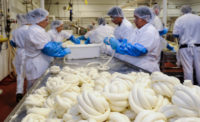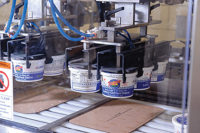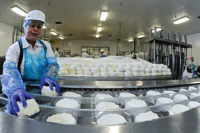The Leitchfield, Ky., plant is also in the process of getting certified. (A third plant is under construction in Brookings, S.D., and is scheduled to begin production by July 2014.)
According Ed Blascak, the plant director at Little Chute, the 144,000-square-foot plant was one of the two within the state of Wisconsin that received FSSC 22000, at that time.
The FSSC 22000 encompasses food safety, employee safety and the entire manufacturing process itself. It was developed for the food manufacturing industry and is based on ISO 22000, the global food safety management standard and PAS 220, a standard developed to address program requirements for food product and ingredient manufacturers, according to Blascak.
The certification is all about “programs, policies and procedures,” said Blascak. He joked that he would repeat that phrase several times when he sat down with Dairy Foods. According to Blascak, it took the plant about 14 months to complete the certification and was “the result of many months of preparation, investments in systems and equipment, changes and improvements in production, maintenance and record-keeping, and numerous hours of training.”
The equipment and systems investments included over $2 million in technological improvements over the past two years, including the addition of a new gourmet spreads production line.
Some of the upgrades in the plant were completed before the certification process was even started.
“We embarked on a green energy initiative four years ago and totally re-lit the plant,” said Blascak. The plant now uses high energy-efficient lighting, which cut down on total electrical use. The plant also recycles about 80% of its total waste materials (corrugated, plastic, etc.) In addition, some of the equipment used to be water-cooled and is now air-cooled, significantly cutting down on water usage, Blascak said.
The importance of safety
Food safety measures are the basis of FSSC 22000 — a complete food safety program.
“We have document control, food safety records, hazard analysis, HACCP plan management, inspection labeling and traceability, internal audits, etc.,” he said. “FSSC 22000 certification is a system approach and requires a new way of thinking. This is a cultural change for how we manufacture our products and requires a continuous improvement mindset. It encompasses the total system from raw ingredients to the consumer.”
He continued, “It’s how you view things and how you look at it. It’s not a program that you start and stop; it’s a program that’s a continuation. And it causes you to sit back and reflect and [take] deep dives into cause and effects, and to eliminate those causes.”
As part of the certification, Bel’s existing allergen program was also put into FSSC format and validated. When the plant receives a product, an allergen tag is put on it, whether it’s one of the eight common allergens or a combination of them.
“It’s flagged right away, so you can see it,” said Blascak.
Each product is stored separately, but like materials are stored together.
Along with emphasizing the importance of food safety, Bel focuses on worker safety.
“We have improved our safety program significantly within the last two years, reducing accidents by 50%,” said Blascak. “Within Bel Group, we are one of the top performers with regard to safety and have shown some of the highest levels of improvement over the past two years.”
He added, “We are very cognizant of employing safety as an everyday way of life within the production system.”
Plant management tries to conduct five-minute safety talks at the beginning of the day as often as it can. Topics have included ladder safety, proper lifting techniques, pedestrian safety and personal safety during the winter season.
“It’s a very good tool to use [because] it keeps it in the forefront of people’s minds,” he continued. “We have monthly topics that we set as an agenda at the beginning of the year. And then we have safety subjects every month.”
The plant also has a safety committee, a safety steering committee and an accident investigation team.
The Little Chute plant was built in 1974 and sits on 16.2 acres. It currently employs over 200 people. Before Kaukauna joined forces with Fromageries Bel and WisPride in 1996, this location was originally a production facility for Kaukauna cheeses (previously made in Kaukauna, Wis.). In 2002, Merkts Cheese Co. joined Bel and WisPride/Kaukauna in Little Chute, which today is all part of Bel Brands USA. The Chicago-based Bel Brands ranks 55 on Dairy Foods’ Dairy 100 and is a subsidiary of Fromageries Bel, headquartered in Paris.
Hubert Fassbender created the Kaukauna cheese brand. Fassbender perfected a cold-pack method of cheese production. The process consists of grinding natural cheese to a fine texture and (without heat) combining it with whey solids, dry milk and flavors such as wine and spices. The flavors come through and the product remains spreadable at room temperature. Today, the port wine and beer cheeses (which are also used in the cheese logs and balls) are some of the company’s biggest sellers.
Fassbender originally sold the cheese in a ceramic crock to local hotels and clubs, which is how it got the nickname “club cheese.” The Kaukauna Klub brand was introduced and copyrighted in 1933, which was also the year the firm began to market the product in the gray ceramic crock. Different versions of that famous crock are on display inside Blascak’s office, and a larger version of the crock is on display out front of the office entrance. The cheeses are no longer produced in ceramic crocks except for special orders. They are now are packed in plastic cups.
Producing the cheese
The Little Chute plant is a cheese converter, making branded and private label cold-pack and gourmet cheese spreads, like Merkts cheeses; Kaukauna cups, cheese logs and balls; Boursin gourmet spreadable cheeses; Price’s sandwich spread; Owl’s Nest and WisPride.
Raw materials consist of finished cheese purchased from U.S. suppliers including First District, Land O’ Lakes and Mullens.
Bel typically makes 800-pound batches at a time. The amount of cheese used varies by the schedule of product that’s being made each day. But the average is about a truckload (40,000 pounds) per day, according to Blascak. The plant produces more than 30 million pounds of cheese a year.
Because the plant adopts a seasonal schedule, employment ranges from a core group of 125 (from January to June) to about 225 employees through December (the peak month of the season is November). The plant goes from one shift to two shifts later in the year. Blascak boasts of their 100% return rate on all seasonal employees for the past several years.
“We have a very high seniority plant. People have been here many years,” said Blascak. The skilled positions go to those who have been there the longest, which can be from 20 to 40 years among the core group. With the seasonal group, who are still considered Bel employees all year round, many have been there from five to 20 years.
On the day Dairy Foodsvisited, production was nearing the end of the busy season. The focus was on popular holiday products, like cheese balls and logs. The plant has four manufacturing rooms, one for cup products, one for its whipped and spreadable cheeses (including some private label), one for the cheese logs and balls, and one for the Price’s cheeses.
Dairy Foodsobserved the production of several, including Owl’s Nest. The cheesemaking process begins with the bulk cheese being fed through cutters (known as cheese harps). The cheesemaker then blends the 40-pound block cheese with barrel cheese and weighs and mixes this on a conveyor.
The barrel and block cheeses are mixed for the various formulations. They pass through the first metal detection and then are extruded through an extractor and out into a vat. (The cheese looks like giant noodles as it comes out.) This goes into a mixing bowl/grinder (the grinders were initially designed for the meat industry and adapted for cheese). The cheese is blended with a slurry (reconstituted whey powder or nonfat dry milk) along with other ingredients (wine, beer, salt, spices, other cheeses, etc.) When mixing is complete, a sample cup of the cheese blend is sent up a pneumatic tube to the lab for testing. The cheese blend is then approved for packaging and goes to the filler, into a cup (packaging process) and through metal detection once again.
After testing, each batch is put on an automatic four-day hold, allowing time for cooling and for more micro-testing to be done. It’s then shipped to a third-party logistics supplier (U.S. Cold Storage) and then distributed.
According to Blascak, every batch his team makes is sampled and tested. The lab conducts microbial tests, organoleptic tests (taste, flavor and color) and finished product tests (fat, pH, salt and moisture content). After testing, the lab keeps retention samples of every batch to the end of the shelf life and beyond.
“Our manufacturing program with SAP (business enterprise software) is a very intensive production module,” said Blascak. “The system requires tracking for every lot number by batch for ingredients and primary packaging, e.g. cup, film, lid. We look for the attributes (chemistry), as well as texture, flavor, color, body of the product. And we taste it.”
The sampling is mainly performed by the R & D manager, quality services manager, production manager and other employees.
WisPride and Boursin go through a similar production process. However these cheeses are whipped prior to filling to give them their creamy textures.
The Kaukauna cheese balls and logs go through a slightly different process. They begin with 40-pound cheese blocks, which are blended on site and aged for two months. The cheese blends are then converted to ball and logs. To do so, they are harped, and then go into a machine that extrudes cheese into either a ball or log. The ball or log is dropped onto an oscillator (conveyor) where the product is coated with almonds. It is then vacuum-packed, passed through a metal detector and packaged for shipping. Once again, the product is held four days for cooling and testing. According to Blascak, 70% of the Kaukauna log and ball production takes place in the fourth quarter of the year, due to its popularity during the holidays.
Happy employees, happy plant
At 2 p.m. every day Blascak meets with his team to go over supply chain, production, quality and scheduling. It’s important to him to review how they’re doing each day and what’s on the agenda for the next day. For Blascak, keeping his door open to employees is important. He even keeps a candy jar on his desk (though he doesn’t eat candy) “to keep people coming in all the time,” he said. “And it works.”
On the day Dairy Foodsvisited the company was offering its first ever health and wellness fair for employees, which took place in the office area of the plant. It was part of what Blascak believes is important: keeping employees healthy and happy. The wellness fair was just one aspect of what the plant provides. Yoga classes are periodically offered in the offices and there is an employee assistance program, which offers financial help and health education. A wellness committee focuses on different topics every month, and the company offers regular screenings, such as blood pressure and health risk assessments. The company also promotes a veggie log (to encourage eating fresh fruits and vegetables).
“Throughout the year we host a number of activities to support our ‘Stay Well with Bel’ Wellness Mission to provide education, resources and incentives to support employees in living a lifestyle of greater physical, mental and emotional well-being,” said Blascak.
Each month a wellness star is nominated by fellow employees and the star for the month is then chosen by the wellness committee. Employees are nominated for making positive lifestyle choices such as losing weight, quitting smoking and working out. It’s opportunities like these, Blascak believes, that help contribute to the plant’s positive return rate for seasonal employees and its longtime staff.
When there are successes and goals are met or something great is happening with an employee, we celebrate it, Blascak said. Events like with the recent certification and employee anniversaries are celebrated with luncheons or dinners.
“We try to recognize when good things happen,” said Blascak.
Read more about Bel Brands USA in “Bel Brands ring true with consumers” in the October 2012 issue.
See a photo album of products made by Bel Brands on our Facebook page. Go to www.facebook.com/DairyFoods.
At A Glance
Location: Little Chute, Wis.
Size of the plant: 144,000 square feet
Number of production employees in the plant: 125 full-time (200+ including seasonal)
Products made: Merkts cold-pack cheese cups; Kaukauna cups, cheese balls and logs; Boursin gourmet spreadable cheese; Price’s real cheese sandwich spread; Owl’s Nest cheese spread cups; WisPride resealable cups and tubs
Total processing capacity: 30+ million pounds a year
Certification: FSSC 22000
Number of shifts: 1 to 2 (depending on time of year)
Warehouse: 73,000 square feet total; 19,000 square feet of dry warehouse approximately; 9 aisles, 8 shipping doors and 5 receiving bays
Storage capacity: 54,000 square feet














